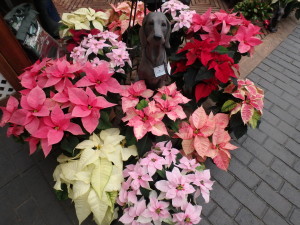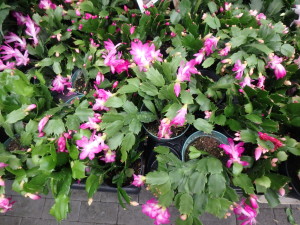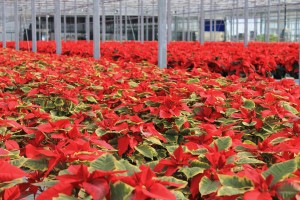Indoor Plants for the Holidays
Florists, garden centers and grocery stores are loaded with color right now – plants that are bright, cheery, and hard to kill. They are just what we need in these dark, dreary days of early winter when the sun goes down before 5pm. Christmas cactus and poinsettias are great plants that are affordable and easy. I recommend them highly.
You may think that poinsettias have big red flowers atop handsome green foliage. Wrong! The colorful parts (they now come in white, pink, plum, burgundy, cinnamon and lemon) are actually bracts, or modified leaves. The flowers are actually just pea-sized yellow blossoms in the middle of the bracts.
Poinsettias were introduced here in 1828 by President Andrew Jackson’s ambassador to Mexico, but only became popular holiday flowers in the 1960’s. A grower in California promoted them heavily on TV, giving plants to the likes of Johnny Carson who kept them on his desk during the Tonight Show.
If you buy a poinsettia, start it off right: be sure it is enclosed in a sleeve or a bag on the way home – they hate the cold. But don’t place it near a wood stove or radiator, either. The ideal temperature is 68 to 72 degrees, but my house is rarely that warm, and they do fine with daytime temps in the sixties and night-time temps a little cooler. Anything below 50 degrees is fatal – but we wouldn’t be happy then, either.
Poinsettias do not require direct sunshine. In fact, bright indirect light is best; six hours is all that is required. And don’t over-water them. Root rot results from keeping roots constantly soggy. Water once a week but check the soil first by probing the top inch with your finger. If it feels moist, you can wait. Experts say it is best to water by placing the pot in a saucer or water and letting it soak up for 15 minutes, but I never do that. I water from the top and it works just fine. I often judge dryness by the weight of the pot, too. The heavier it is, the more water is in the pot. Fertilization is not recommended when they are in their bloom cycle.
Although I don’t usually do it, you can keep your poinsettia over the summer and hope to get it to produce colorful bracts next winter. These plants are photoperiodic, which means they are sensitive to daylight length. They need 14 hours of darkness each night in the fall if they are to “bloom”. Even electric lights on in their room can interfere with the coloring-up process, I’ve read.
Christmas cactus often bloom for Christmas, though if you keep them for years they may bloom at other times. Buy one now, and you’re pretty much guaranteed blossoms through the holidays. Properly cared for, a Christmas cactus can be handed down to your kids … and later, their kids.
Like poinsettias, a Christmas cactus needs bright, indirect light and moderate temperatures. Over-watering can be lethal, so if you are starting a new plant from a cutting, add some sand to the potting mix for increased drainage. One part sand to three parts potting mix is about right.
Christmas cacti are not true cacti – they wouldn’t survive in a desert – so you shouldn’t let them get too dry, either. Feel the soil weekly – when the soil is dry an inch below the surface, it’s time to water. If you water too much or too little you will notice flower buds falling off.
A Christmas cactus does best with humidity in the 50 to 60% range. If you have a wood stove, chances are your house is drier than that in the winter. You can remedy the situation by filling a wide saucer with small stones, add water, and placing the potted plant on the stones. As the water evaporates, it adds humidity to the air around the plant.
Aside from these colorful plants, I like to add some greenery around the house in winter. I have a number of foliage plants, but also like to pick some pachysandra outdoors to keep in vases, or to fill out bouquets of flowers I buy.
Pachysandra is a shade-loving vine with year-round glossy leaves. Even with snow on the ground you can pick stems and place them in a vase of water, where they will thrive all winter. The leaves stay glossy and green and will develop good roots in a vase. In the spring I plant them outdoors in shady places as a ground cover. Right now I have a vase full of pachysandra stems with a few twigs of red winterberries, which is quite festive.
Despite my careful attention to my outdoor plants – both vegetables and flowers – I have never paid near as much attention to indoor plants. Perhaps I need a break in winter, when they are needing my care the most. So it is important to me that house plants be relatively undemanding. Poinsettias and Christmas cactus fill the bill.
Read Henry’s twice-weekly blog at https://dailyuv.com/
Poinsettias
I like poinsettias and buy one every year. And every year the poinsettia industry produces new colors and shapes for the “flowers”. Standard red has given way to pink, maroon, white and red, pink and red; simple bracts are now double, double with ruffles. There is always a call for the new and different. Me? I’m a simple gardening guy who likes the simple old fashioned kind.
Botanically speaking, those red parts of a poinsettia are actually called bracts. The flowers are the tiny yellow center of each “flower”, and the red bracts are leaves purely for decoration – and an advertisement to any stray pollinator (or shopper) that might be around.
Poinsettias are native to Mexico, and were first introduced to the United States in 1828 by President Andrew Jackson’s ambassador to Mexico, Joel Poinsett. But they have traveled the world. When I was working in Bamako, Mali, West Africa, in the early 1980’s, I had hedges of poinsettias that were five feet tall. But it took a long time for poinsettias to become popular.
In 1923 a grower named Paul Ecke started growing them in quantity in California, selling plants wholesale and shipping them by rail all over the country. He worked on growing good, durable plants that he sent to growers so that they could start cuttings and make more plants. He was a trained horticulturist, but also a good marketer. He gave free plants to TV hosts like Johnny Carson and Bob Hope for his Christmas Special every year. Through the magic of TV he got Americans to associate the idea of Christmas with poinsettias.
One reason that poinsettias are so popular is that they are easy to keep looking nice – even those folks with “brown thumbs” can keep them going for a couple of weeks or more. They are almost like plastic plants. And most of us feel no guilt about throwing them out when they start to look ratty.
If you’ve never offered a home to a poinsettia, here’s what you need to do: Water it once a week, give it some indirect light, and avoid placing it in a cold or drafty place. Temperatures of 68 to 72 are recommended, but my house is rarely that warm, and they do fine for me. And don’t put it on top of a radiator or anywhere where it will get too hot and dry out too quickly.
The worst thing you can do for a poinsettia is to overwater it. Too much water will rot the roots, and your holiday plant will go into a decline and die. I lift the pot and can tell by its weight whether it needs water or not. But you can stick your finger in the soil, too. If it is wrapped in foil, make a hole in the bottom so that excess water can drain into the saucer.
Getting poinsettias to bloom in their second year is complicated, and not worth the effort for most of us. One must give them bright light during the day, and no light at all for 12 hours or more – which means moving them into a closet or basement, and remembering not to turn on the light. I have read figures citing 5 days of dark treatment as adequate, but also up to 10 weeks of dark from 5pm to 8am. Who knows? I once read read that a big grower had trouble getting his plants to develop their red leaves simply because he had a night watchman who liked plants and shined his flashlight around the greenhouse on his nightly rounds.
My mother, may she rest in peace, never had poinsettias because she believed, mistakenly, that they were poisonous. She feared that her cat would eat a leaf and die. I told her that was not the case, but she was a worrier, and wouldn’t take a chance with her dear cat, Bella (may she, too, rest in peace).
Ohio State University in cooperation with the Society of American Florists did a study that proved that poinsettias are not the threat my mom believed they were. Yes, they are in the genus Euphorbia, a group of plants that have alkaloids in their white sap. But the sap is not very toxic. According to the Mayo Clinic web site, poinsettias are not good to eat, and might cause a tummy ache or a rash, but unless you are allergic to them, nothing serious is likely to happen if you make them part of your lunch. Or your cat’s lunch.
From a Darwinian point of view, it might make sense for a plant to make itself poisonous, or at least unpleasant to eat. After all, plants want to reach maturity and produce seeds, allowing their genetic material to be passed on to the next generation. They don’t want all their leaves to be eaten before maturity. But the bottom line is, feed your cat well, and she probably won’t even get a tummy ache from nibbling your poinsettia.
So get yourself a poinsettia. They will provide some nice color on your table for the holidays. Just don’t water it too much.
Henry Homeyer is the author of 4 gardening books. His Web site is www.Gardening-Guy.com.






